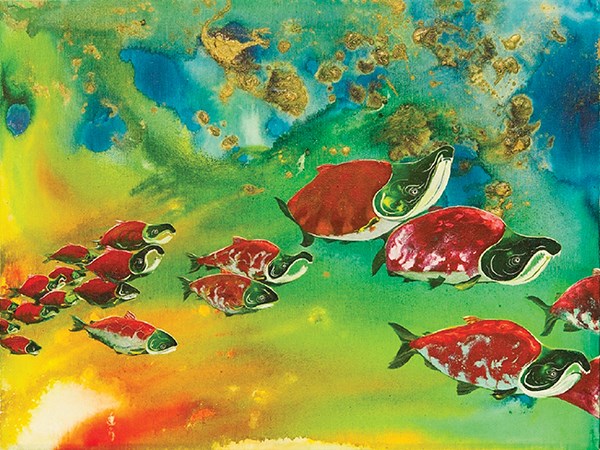In October of 2014, visual artist Sanaz Busink noticed bald eagles perched atop trees all over Squamish. They reminded her that the salmon must be spawning, so she headed to the Mamquam River and sat and watched the “spectacle of salmon” that had travelled thousands of kilometres of ocean to return to the river of their origin.
“I am not sure what was it that evoked and inspired my passion for painting salmon that day,” Busink says. “Maybe it was the energy in our rivers, or maybe it was the struggle for reproduction or the power and wonder of the cycle of life. The echoes of the day continue to reverberate in my soul… the ripple of the water, the rustle of the fall leaves in the breeze, the shriek of a distant eagle. I recall the smell and feel of the crisp fall air vividly striking my senses as I lost myself in this magical dance of life. Without notice, my emotions were effortlessly overpowered as I sat misty-eyed on the river bank.”
Later that afternoon, Busink’s passion and empathy for the salmon merged into a powerful force that coerced her into her painting studio. The splashing of fish turned into the splashing of different shades of blues and greens onto the canvas, recreating the emotion and beauty of the moment that she had experienced earlier that day.
“Since then,” she says, “my creative explosion continued to create countless paintings in a manner that verged on obsession. Several times a week, I found myself realizing that it was 2 a.m. after a night absorbed in art, transferring my memories onto the canvas. Sometimes the entire floor was covered in canvases full of salmon, as if the spawning run had found its way into my studio.”
To emulate the raging water, Busink’s process starts with an abstract, river-coloured background painted in a studio space that will tolerate splashing, pouring, spattering and flinging brushes bleeding with acrylics. After each background dries, she moves on to laying out the composition starting with the green salmon head, then the red, orange and pink bodies of each fish. Busink then meticulously renders the handpainted fins, gills, tails and the beveled fish eyes and sharp, crooked teeth required for going to war over their chosen mates. “I most enjoy painting the scars and bruises from these evolutionary battles of procreation,” says Busink.
Once the painting has reached its natural conclusion, Busink applies a thick coat of resin which is the last, most technical part of protecting and giving life to the salmon canvas.
The coat of gloss goes on with the consistency of tar and requires a blow torch to remove the bubbles as it dries like glass on top of the fish. The resin gives the painting a three-dimensional look, creating the feeling you are underwater witnessing the salmon swim right in front of you.
Through mostly online promotions, Busink has had a lot of success selling numerous salmon paintings.
She says with delight, “I had no idea our native fish would impact my mind and soul in such a profound manner or generate the local interest that it has. I am grateful to have lived in an area that teems with so much life and vitality – a place where the rivers run deep, the mountains stand tall, and the salmon perform their magical dance of life.”
Although Busink is still accepting commissioned salmon paintings, she has had a “good run” (excuse the pun) and these are the last of her salmon journey on the canvas. The Salmon Spawn exhibit will remain on display until July 4.
Also, in the Foyer Gallery display cases this month, Lélé Leblanc McLeod presents a sampling of her handmade pouches and backpacks fashioned from recycled fabrics and adorned with lino-cut acrylic printed fish; her work is entitled “The Life and Times of Deadeye Sam Klamath.”
Editor’s note: Toby Jaxon is curator of the Foyer Gallery, located at the entrance to the ������ƵappPublic Library on Second Avenue.




